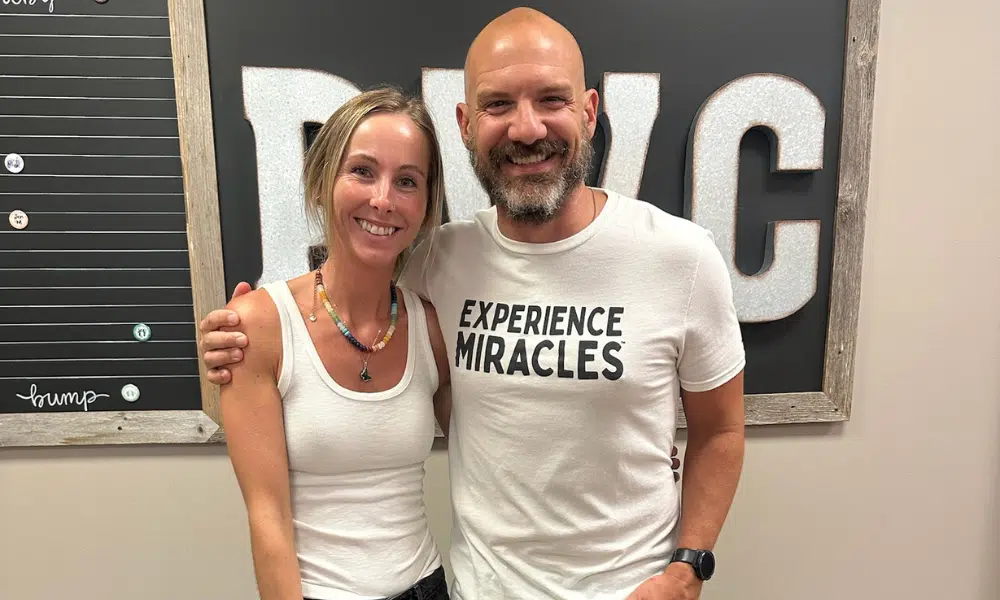“Oh boy, you must be exhausted all the time!” is what the judge said to me emphatically during a dreaded day spent on the brink of jury duty a few years back.
Nothing gets us wildly busy, usually overscheduled, wound up, and worn out (at the same time somehow), parents freaking out more than receiving that jury duty notice letter in the mail. That dreaded day got even worse for me, as I ended up having to stay there all day, getting selected to actually go into the courtroom itself for the final round of jury selection.
That’s when the judge said those words that have stuck firmly in my head all these years later. While going around getting to know the personal story of each potential juror, I, of course, let them know that I’m a Pediatric and Family Chiropractor, owner/operator of 3 incredible companies (missions), and best of all, father to four (4) incredible children.
That’s when he hit me with the same thing every other person always assumes to be true – that I’m worn out and exhausted all the time!
Nope.
Definitely not.
Try again.
This commonly accepted parental truth is the problem that we’ll be tackling head-on with this life-changing article for truly exhausted parents – the assumption that we’re all constantly tired and hating life is one that needs to go away, yesterday!
While you’re probably not supposed to “talk back” to a judge, after sitting in that courthouse all day wasting away what could have been a wildly productive (formerly known as “busy”) day, I had simply had enough of it. I responded with, “Actually, sir, I sleep 7-8 hours a night, work out every day, eat healthy, get adjusted 1-2x per week, and have ten times more energy now than I did when I had no kids!”
After I said that, the entire courtroom stayed silent for what felt like an hour and just stared directly at me. Honestly, I loved it!
I have spent my whole life not only fully committed to helping kids get their health and vitality back, but also their parents – making sure we get all the stress, tension, and exhaustion OFF their nervous system, and help them get their energy, mental and emotional health, and what I like to call “mojo” back rocking and rolling again!
That’s why I can’t wait for you to read this article and, most importantly, put the action steps at the bottom of it in play for your life too. These strategies work no matter how many kids, no matter what health battles you’ve faced in the past, and no matter how many stress-busting and supposed energy-providing supplements, IV infusions, diet changes, and detoxes you’ve tried!
Spoiler alert – thankfully, as soon as I let them know I was quite happy, positive, and highly energized, they dismissed me from jury duty. Evidently, they want their jurors stressed out, worn out, and grumpy.
Parent Exhaustion: Common But Not Normal
If you’re reading this, there’s a good chance you are feeling exhausted.
Not just tired from a long day, but bone-deep exhausted from months or years of pushing through chronic stress, brain fog, digestive issues, autoimmune issues, and that constant feeling that your body is stuck in overdrive.
An alarming number of adults today live with at least one chronic health condition, according to the CDC. From digestive disorders and sleep problems to anxiety and chronic fatigue, we’re facing an epidemic of nervous system dysfunction that keeps us trapped in survival mode.
But what if there was a common thread underlying your seemingly unrelated symptoms? A root cause that, when addressed, could unlock your body’s innate potential for healing and thriving?
That missing piece of the puzzle is often subluxation and dysautonomia – a neurological dysfunction that develops over years of accumulated stress and keeps your nervous system locked in a state of hypervigilance. While the concept of subluxation applies to all ages, the way it manifests in stressed-out adults creates a unique pattern of symptoms that traditional medicine often misses or mislabels as separate conditions.
When your conventional doctor dismisses your concerns, continues to prescribe another medication, or tells you “it’s just stress” or “part of getting older,” it simply means they lack the understanding and ability to look deeper into the root cause of your health challenges, and are especially incapable at understanding neurological function and how it affects every system in your body.
Additionally, wound-up and worn-out parents may feel similarly lost when trying to navigate the world of functional or integrative medicine. Many parents report to us they’ve spent thousands on various lab tests (blood work, hormone testing, stool samples, etc.) and tried dozens of different vitamins, supplements, and so forth to try and get their energy and well-being back – and still seem to struggle, feeling like now they’re chasing symptoms with supplements instead of medications.
To help you truly get to the real root cause of your chronic fatigue and burnout, let’s explore subluxation, how it develops, and its far-reaching impact on your health. We’ll also explore the factors that can lead to subluxation, how it can show up as various symptoms and conditions, and how Neurologically-Focused Chiropractic Care can help in ways you likely never knew!
How Subluxation Keeps Adults Stuck in Stress Mode
For stressed adults, subluxation isn’t just a mechanical issue – it’s a neurological trap that keeps your body in a constant state of fight-or-flight “protection mode.” Unlike acute injuries that heal, subluxation in adults develops through decades of accumulated stress, creating a self-perpetuating cycle of tension and dysfunction.
A Scientific But Simple Framework of Subluxation:
1. Structural Component (Misalignment):
Stress and tension can shift the NeuroSpinal System, particularly in the neck, shoulders, and lower back, out of optimal alignment, thereby altering biomechanics and posture.
2. Functional Component (Fixation):
Restricted or altered joint motion reduces proprioceptive input – the movement-based signals your brain depends on for energy, focus, balance, coordination, and nervous system regulation.
3. Neurological Component (Interference):
When that input changes, the brain’s output changes too – leading to a “stuck on” sympathetic fight-or-flight stress response along with a decreased parasympathetic and vagus nerve function, and therefore common health challenges like constant muscle tension, headaches, sluggish digestion, weakened immune response, chronic inflammation, imbalanced hormones, energy drain, and decreased adaptability overall.
When subluxation sets in, it significantly interferes with proper functioning of the nervous system, which is responsible for controlling and coordinating all the systems in the body. Nervous system dysregulation and dysfunction are easily the most overlooked and dismissed components of both acute and chronic health challenges in adults.
The key component of subluxation that sets all neurological dysfunction in motion is joint fixation and restriction of movement, known as proprioception.
Proprioception is the body’s sense of position and movement. It relies on sensory receptors in the joints, muscles, and connective tissues to communicate with the brain. Subluxation disrupts this communication, leading to decreased proprioception and an increased perception of noxious or stressful stimuli, as well as input into the brain (nociception).
This is the more scientific and nerdy explanation of why it’s often said that “motion is life” – and explains why the shift to far more sedentary living has become such a major trigger for chronic illness in our current world. While it’s definitely not the only trigger of subluxation and stress on the nervous system, we’d have far less trouble with it if adults (and children as well) could spend less time stuck at a desk, sitting in a vehicle, or on the couch, and instead that time was spent walking, stretching or doing mobility exercises, and working out.
In stressed-out adults, decreased proprioception and subluxation can really dig deep into the nervous system over time and present as chronic pain and tension, brain fog, sensory overload, digestive dysfunction, disrupted sleep patterns, and especially as altered stress response and emotional regulation.
Subluxation plays a major role in the development of chronic fatigue, anxiety disorders, and the inability to “turn off” from stress. This is why so many parents notice themselves constantly being on edge and having a “short fuse” with their children, spouse, and other family members.
The upper neck, shoulders, and brainstem region are particularly vulnerable to subluxation because they house a high concentration of proprioceptors and are responsible for controlling many vital functions in the body, such as:
- Breathing
- Heart rate
- Blood pressure
- Digestion
- Immune function
- Inflammation
- Sensory processing
- Stress response regulation
Additionally, the upper neck and brainstem are in close proximity to the vagus nerve and the autonomic nervous system, which regulate the body’s involuntary functions. The autonomic nervous system is divided into two branches: the sympathetic nervous system, which is responsible for the “fight or flight” response, and the parasympathetic nervous system, which is responsible for the “rest and digest” functions and overall nervous system regulation.
Subluxation of the spine or brainstem can disrupt the balance between the sympathetic and parasympathetic nervous systems, leading to a wide range of symptoms and health challenges. This imbalance, known as dysautonomia, is a critical factor in many of the chronic health conditions we see in adults today and something completely overlooked by conventional medicine.
The Adult Perfect Storm: Why You Can’t Just “Manage Stress Better”
While children develop subluxation through birth trauma and early life stressors, adults face a different challenge – the cumulative burden of decades of unresolved neurological tension and stress. Many adults are dealing with what we call “The Adult Perfect Storm” – layers of neurological dysfunction that began in childhood and compounded through adult life stressors and stages of subluxation.
Life Stressors: The Accumulation Effect
While it is likely that most adults also went through common childhood “Perfect Storm” factors like a traumatic birth, disrupted neurological development, sensory processing challenges, and exposure to constant toxins, chemicals, antibiotics, and other medications, unfortunately, for most adults, that storm continues to layer on through these three (3) types of chronic stressors.
1 – Physical Stress:
- Car accidents and whiplash injuries
- Sports injuries and falls
- Poor posture from desk work and technology use
- Repetitive stress injuries
- Lack of movement and exercise
2 – Chemical Stress:
- Chronic medication use, especially antibiotics, antipsychotics, and pain relievers
- Environmental toxins and air pollution
- Processed foods and an inflammatory diet
- Alcohol and caffeine dependency
- Hormonal imbalances
- Environmental toxic overload in soaps, cleaning products, makeup, etc.
3 – Emotional & Mental Stress:
- Work pressure and burnout
- Financial stress
- Relationship challenges
- Caregiving responsibilities
- Trauma and unresolved emotional patterns
When you experience these stressors year after year, your nervous system can become stuck in a state of “fight or flight,” leading to chronic tension and imbalance. This sympathetic dominance interferes with your ability to rest, digest, heal, and recover, creating a vicious cycle of stress and dysfunction.
The key insight is that subluxation isn’t just about current stress – it’s about the accumulation of neurological dysfunction that may have started decades ago and never been properly addressed.
Why Meditation, Exercise, and Therapy Aren’t Enough
You’ve probably tried everything to manage your stress – meditation apps, yoga, therapy, exercise, supplements. While these are valuable tools, they often fail to provide lasting relief because they don’t address the underlying neurological dysregulation. It’s like trying to calm a smoke alarm by fanning away smoke while the fire still burns.
When subluxation is present, your nervous system cannot physically access the calm, parasympathetic state that these practices aim to create. The neurological pathways are blocked. This is why you might feel temporarily better after yoga but find yourself right back in stress mode hours later. The structural and neurological interference must be addressed first.
The Stress-Subluxation Syndrome: Recognizing the Pattern in Your Body
Unlike children who show developmental delays or behavioral issues, subluxation in stressed adults creates a distinct pattern of symptoms that often gets dismissed as “just stress” or “normal aging.” These aren’t separate conditions – they’re all connected together via subluxation, nervous system dysregulation, and dysautonomia.
Common signs of chronic subluxation include:
Neurological and Mental Health Symptoms
- Brain fog and difficulty concentrating
- Memory problems and mental fatigue
- Chronic headaches and migraines
- Anxiety and panic attacks
- Depression and mood swings
- Emotional dysregulation and overwhelm
- Inability to “shut off” racing thoughts
- Sensory sensitivity to light, sound, or touch
Physical and Autonomic Symptoms
- Chronic neck, back, and shoulder tension
- Poor posture and restricted range of motion
- Digestive issues, including IBS, constipation, and reflux
- Sleep disorders and insomnia
- Chronic fatigue and low energy
- Heart palpitations and blood pressure issues
- Temperature regulation problems
- Dizziness and lightheadedness (POTS symptoms)
- Weakened immune function and frequent illness
- Exercise intolerance
Performance and Quality of Life Issues
- Decreased productivity at work
- Difficulty handling stress
- Poor recovery from physical activity
- Reduced resilience to daily challenges
- Feeling “stuck” in survival mode
- Inability to fully relax or unwind
The Hidden Cost: What Subluxation Steals From Your Life
Beyond the symptoms, subluxation in stressed adults creates a cascade of life impacts that compound over time:
Career Impact: Brain fog and fatigue can significantly impact your performance, creativity, and decision-making. Opportunities pass by while you’re just trying to survive each day.
Relationship Strain: When you’re stuck in fight-or-flight, you have little emotional capacity left for meaningful connections. Partners and children get the depleted version of you.
Lost Years: Many adults don’t realize they’ve been living at 40% capacity for decades. The tragedy isn’t just feeling bad – it’s all the life you’re missing while in survival mode.
While these symptoms can indicate the presence of subluxation and specific patterns of neurological dysfunction, it’s important to note that addressing subluxation is not a direct treatment or cure for any symptom or condition.
Subluxation-Based Nervous System Focused Chiropractic Care, which we’ll explain in more detail below, addresses subluxation and nervous system dysregulation effectively and simply to help improve overall neurophysiological function within the body. From there, the body is more than capable of healing and restoring itself all on its own!
This is where the chiropractic and medical approaches differ substantially. While medical care aims to address the symptoms of a condition, chiropractic seeks to address the underlying root cause and provide care that improves nervous system function first and foremost, allowing the body to address the symptoms and conditions more effectively on its own.
Breaking Free From the Stress-Subluxation Cycle: The Neurological Reset You Need
At PX Docs, we understand that stressed adults need more than temporary relief – they need to break the neurological patterns that keep them trapped in chronic stress. While it’s amazing that so many “health hacks” and “bio hacks” now show up on our Instagram feeds and Facebook groups, there is a vast difference between nervous system repair and regulation.
Most chronically stressed adults and parents need at least a few weeks to months of nervous system repair work before regulation activities like meditation, breathing exercises, infrared saunas, red light therapy, cold plunges, certain supplements, and so forth will have any positive effect on the body, or at least one that lasts more than a few hours or a couple of days.
Our approach specifically targets the stress-subluxation cycle that has developed over years or decades. Our doctors undergo extensive training in Neurologically-Focused Chiropractic Care, enabling them to provide personalized care plans, specific adjustments, and fully customized recommendations tailored to your unique neurological patterns and overall needs.
True Neurologically-Focused Chiropractors do not just rely on symptoms, postural distortions, x-rays, or palpation for their pattern analysis and clinical results, but instead utilize cutting-edge technology called the INSiGHT Scans to take their work to a whole new level.
It only takes a matter of minutes to run these scans, and the amount of wildly insightful clinical information they provide a nervous system-focused chiropractor is truly incredible.
The INSiGHT Scans consist of the 3 specific scans, including:
- NeuroThermal: Measures asymmetrical infrared heat patterns within the neurospinal system, detecting patterns of regional dysautonomia and nervous system dysregulation that often lead to challenges with digestion, immune function, and hormones.
- NeuroCore (sEMG): Assesses patterns of neuromuscular dysfunction, asymmetry, tension, exhaustion, and more, helping determine which components of neurospinal motor function are most negatively affected and interfered with. These scans help really sort out where all that physical tension, stress, and dysfunction have set up shop.
- Heart Rate Variability (HRV): Evaluates how subluxation and nervous system dysfunction have affected overall autonomic function, adaptability, and reserve capacity (energy). HRV is a direct and effective measurement of dysautonomia.
These INSiGHT Scans help our PX Doctors look far deeper into patterns of subluxation and neurological dysfunction than traditional analysis methods like X-ray, posture, and palpation. Those are still fantastic and helpful methods of subluxation and pattern analysis, but the INSiGHT Scans stand alone as the gold standard in today’s practice environment.
The clinical application of these scans and pattern analysis goes far beyond just the initial look into subluxation and neurological dysfunction, and also allows our PX Docs to do the following:
- Create Customized Care Plan: Pattern analysis enables chiropractors to develop a more individualized care plan based on the specific neurological patterns they observe in each patient. This can lead to more targeted and effective adjusting techniques and approaches, rather than using the same approach for each and every patient.
- Specific, Targeted Adjustment Techniques: While most chiropractors focus on one singular adjusting technique and force fit every patient into it, our PX Docs utilize INSiGHT Scans and other analysis components to know exactly which technique will be most effective for your specific nervous system needs. Some patients will benefit from a very light, low-force tonal approach, while others who have reached that stage of neurological exhaustion will need techniques that promote more vagus nerve activation and stimulation.
- Tracking Progress: By continually assessing the patterns before and after a series of adjustments (usually six to twelve), our PX Docs can determine the effectiveness of the care being provided and make necessary modifications to the care plan or adjusting protocols if needed.
Below is an image of Initial and Progress EMG Scans on an adult patient who was struggling with chronic stress, anxiety, and exhaustion initially, then experienced all sorts of improvements with care, such as decreased tension, increased mobility and energy, no more brain fog, better focus, and a vastly improved ability to handle stressful situations and stay calm.


As shown in the initial top EMG scan, their nervous system was overwhelmed with excessive tension and stress (red and blue areas). After 2-3 months of care, their subluxation and nervous system stress were reduced, resulting in the calm, regulated scan on the bottom (white and green areas).
Neuro-Tonal Subluxation Analysis + Adjusting
While nothing provides the comprehensive and in-depth level of subluxation analysis quite like the INSiGHT Scans, each of the doctors in our PX Docs Network is trained in our Neuro-Tonal Analysis and Adjusting system as well.
Each and every visit, our doctors go through a series of sequential neurological patterns and subluxation analysis checks that allow us to determine exactly which regions and areas need targeted adjustments, as well as which particular adjusting techniques are going to be most effective for that particular visit.
This is where PX Doctors are quite different from even other nervous system-focused and subluxation-based chiropractors, in that we do not adhere to the same adjusting technique and protocol for every single patient. Instead, we work hard to adapt and pair the most effective adjusting technique with each patient, every visit, and every adjustment.
From Surviving to Thriving: Reclaiming Your Stress Resilience
You weren’t meant to live in constant survival mode. Your nervous system is designed to handle stress and then return to baseline – but subluxation breaks this natural recovery and regulation mechanism. When subluxation patterns that may have started decades ago are finally addressed, something remarkable happens – your body remembers how to relax.
By understanding how subluxation specifically affects stressed adults and seeking the care of a qualified PX Doctor, you can finally break free from the exhausting cycle of chronic stress. Our Neurologically Focused Chiropractic Care directly addresses the accumulated neurological dysfunction that keeps you stuck in fight-or-flight mode.
Many adults are surprised to discover that symptoms they’ve dealt with for years – even decades – can improve significantly in just a matter of a few weeks to months of focused, targeted nervous system care. You don’t have to accept chronic stress, fatigue, and health issues as your “new normal” – you can experience all the energy, joy, and vitality you want!
If you believe you may be dealing with subluxation or any of the symptoms of nervous system dysregulation we’ve discussed, we recommend visiting the PX Docs Directory to begin your journey toward vastly improved health and optimal neurological function!
Our network of highly trained and compassionate chiropractors is dedicated to helping adults break free from the cycle of chronic stress and reclaim their quality of life once again.



![[GRID] Calming the Sensory Storm WEBINAR PX Docs Webinar](https://pxdocs.com/wp-content/uploads/2025/11/GRID-Calming-the-Sensory-Storm-WEBINAR.png.webp)


